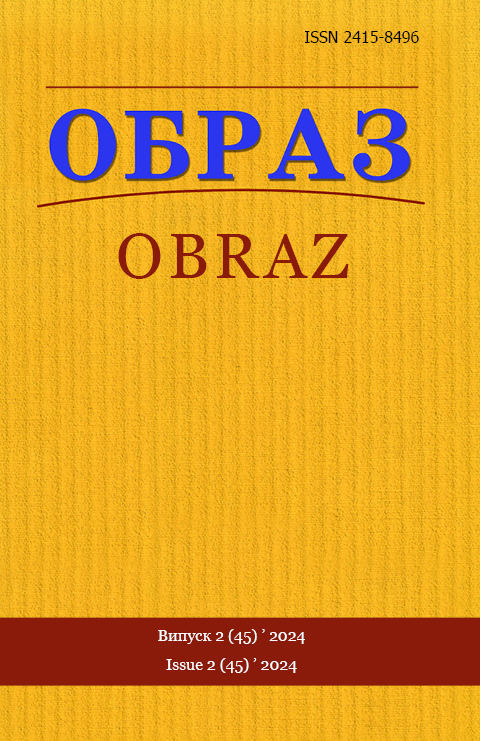Abstract
Introduction. The media image of a city is determined by a set of mediatisation factors and a wide network of media that present it. The media image of a city is formed taking into account the city’s history, architecture, its “ knowability” by prominent fgures, places, brands, business strategies, commercial component, and public opinion.
Relevance of the study. These components make it possible to conclude that the media play a major role in the life of an urban community. The analysis of the media content of regional media contributes to the formation of an idea of the image of the city as it appears to the recipients. The focus of scientifc interest is the Sumy online publication “Tsukr”, which content is of interest for establishing a positive media image of the city of Sumy.
Methodology. The study used general scientifc methods of analysis and synthesis, systematisation and generalisation of material, content analysis, and some aspects of discursive and narrative methodology. The study is based on the principles of objectivity and academic integrity.
Results. The media signifcantly form the images of different spaces. Media technologies (video, online spaces, regional and national media outlets, various advertising campaigns, etc.) and an active process of digitalisation are used to create images of cities, towns, and communities. The process of city mediatisation allows us to focus on the key factors of city image formation, which are components of geocultural and urban image studies, among which the most important are regional print and online media, a developed system of television and radio communication, historical and cultural presentation of the city in the media environment, as well as active
processes of media convergence. The article focuses on the content of the Tsukr publication, which informs about events within a specifc locale/region/territory, is a common communication space for Sumy residents and a source of feedback between them.
Conclusions. The analysis of the content of the regional online publication “Tsukr” proves that it is one of the most influential media outlets in Sumy, which actively generates the image of a successful, economically strong, prosperous, cultural city.
References
1. Zmiу, L. (2010), “Modern Media Culture of the Region: Problems of Formation”, Visnyk Kharkivskoho natsionalnoho universytetu imeni V. N. Karazina [Bulletin of V. N. Karazin Kharkiv National University], Iss. 891, Pp. 100–104.
2. Koliastruk, O. (2008), “Visual documents as special sources of the history of everyday life”, Ukraina XX st.: kultura, ideolohiia, polityka [Ukraine in the 20th Century: Culture, Ideology, Politics], Iss. 12, Pp. 259–264.
3. Matviienkiv, S. (2022), “Regional Media: Defnition of the Concept and Peculiarities of Functioning in the Context of the Russian-Ukrainian War in 2022”, Istorychni, politychni, kulturno-osvitni, relihiini, ekonomichni ta pravovi aspekty : naukova monohrafia [Historical, political, cultural, educational, religious, economic and legal aspects : a scientifc monograph], “Baltija Publishing”, Riga. 1436 p. Pp. 992–999.
4. Matviienkiv, S. (2017), “Regional media as an instrument of local identity formation”, Politychne zhyttia [Political life], Iss. 4, Pp. 83–86.
5. Otrishko, M. A. (2020), “Using cultural and creative industries as a way to revitalise a small town”, Visnyk Natsionalnoi akademii kerivnykh kadriv kultury i mystetstv [Bulletin of the National Academy of Management Personnel of Culture and Arts], Iss. 3, Pp. 40–45.
6. Otrishko, M., Harkevych, M. (2024), “Media culture as a factor in shaping public opinion in small towns”, Obraz [Image], Iss. 1 (44), Pp. 158–167.
7. Polischuk, Yu. (2017), “The concept of “social consolidation” in the national political science discourse”, Naukovi zapysky IPiEND im. I. F. Kurasa NAN Ukrainy [Scientifc Notes of I.F. Kuras Institute of Political and Economic Studies of the National Academy of Sciences of Ukraine], Iss. 5–6 (91–92), Pp.. 158–171.
8. Rudenko, V. (2023), “Volunteering as a Leading Phenomenon in the Process of Ensuring Social Security in Ukraine: Evolution, Signifcance, Current Status and Issues”, Ekonomika ta suspilstvo [Economy and Society], Iss. 52, available at : fle:///C:/Users/ACER/Downloads/2546-Текст%20статті-2458-1-10-20230727.pdf
9. How Tsukr’s work has changed since 24 February: a blog by Dmytro Tishchenko. Tsukr [Tsukr], 17 August 2022, available at : https://cukr.city/people/2022/cukr-in-war/
10. Avraham, Е. (2000), “Cities and their news media images”, Cities, Vol. 17, Iss. 5, Pр. 363–370.
11. Christmann, G., Singh, A., Stollmann, J., Bernhardt, Ch. (2020), “Visual Communication in Urban Design and Planning: The Impact of Mediatisation(s) on the Construction of Urban Futures”, Urban Planning, Vol. 5, Iss. 2, Рp. 1–9.
12. Hepp, A. (2013), Cultures of mediatization. Cambridge: Polity Press, 180 р.
13. Lynch, K. (1960), The Image of the City. Cambridge MA: MIT Press, 208 р.
14. Yiyang, Qiu. (2022), “How Ofcial Media Can Use Social Media for Urban Marketing (Take the Shenzhen Health Care Commission as an Example)”, ICEDBC, Vol. 225, Рp. 63–71.
15. Qimin, Hu, Ziqi, Li, Yilin, Qiao, Siyuan, Yin. (2023), “Impact of New Media Development on City Image”, Communications in Humanities Research, Vol. 5 (1), Рp. 367–371.

This work is licensed under a Creative Commons Attribution 4.0 International License.

